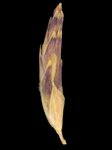
T. infesta spikelets.
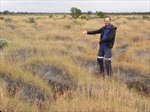
T. infesta habitat.
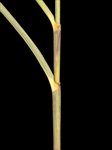
T. infesta orifice and sheath.
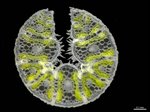
T. infesta leaf section.
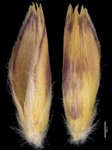
T. infesta lemmas.
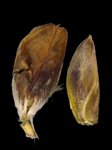
T. infesta paleas.

T. infesta map.
Name
Triodia infesta B.M.Anderson & M.D.Barrett, ined.
Citation
Austral. Syst. Bot., in press, (2017)
Derivation
infesta — from the Latin infestus (hostile, dangerous, infested) in reference to the frequent observation of insect larval infestation in the florets.Common name
Infested Spinifex
Synonyms
None
Diagnostic features
Foliage non-resinous; leaf sheath surfaces glabrous except for shortly hairy margins; orifice shortly hairy; inflorescences unbranched; pedicels 1–3 mm long; leaf blades amphistomatous (hard-type); lower glume 5.2–6.2 mm long, elliptic, 6–9-nerved; lemmas shortly lobed, uniformly textured (indurated for most of their length and scarcely differentiated from lobes), lobes 0.5–1 mm long, not awned; distribution in Little Sandy and Great Sandy Deserts, and northern Murchison and eastern Gascoyne regions.
Habitat
Occurs on red loamy flats, dunes or rocky hilltops.
Distribution and frequency
Endemic to interior Western Australia. Rare and only known from a few scattered localities in the Little Sandy and Great Sandy Deserts, and northern Murchison and eastern Gascoyne regions.
Similar species
Triodia infesta belongs to the Basedowii group, sharing the group features of non-resinous foliage, amphistomatous (hard-type) leaf blades and many-nerved (≥6) glumes.
Triodia infesta is distinguished from all other Basedowii group species except T. mallota and T. plurinervata by having an unbranched inflorescence (lacking side-branches and spikelets inserted directly on the main axis), and short pedicels 1–3 mm long (inflorescence either branched, or if unbranched then longest basal pedicels more than 3 mm long).
Triodia mallota is distinguished from T. infesta by being densely woolly on sheath surfaces (glabrous except for shortly hairy margins in T. infesta), and occurs near Pannawonica in the Pilbara (T. infesta east and south of the Pilbara).
Triodia plurinervata is distinguished by having shorter spikelets (5–9.8 mm long) shorter glumes (3–4.2 mm long), and subcoastal distribution (spikelets 12.5–17 mm long; glumes 5.2–6.2 mm long and interior distribution in T. infesta).
Conservation status
Priority Three recommended.
Identification without florets
Triodia infesta is the only species in the Great Sandy or Little Sandy deserts that shares the combination of unbranched inflorescences and many-nerved (≥6) glumes.
Triodia spicata is similar and occurs in the same area and also has an unbranched inflorescence, but has 1–3-nerved glumes (glume nerves 6–9 in T. infesta).
Variation
Very variable in habitat, from low-lying flats and rises near saline areas, to rocky hill tops.
Notes
Triodia infesta was considered under a broad concept of T. plurinervata by Lazarides (1997), Lazarides et al. (2005) and Ausgrass (Sharp & Simon, 2002; Simon & Alonso, 2014). A full description of T. infesta can be found in Anderson et al. (2017a).